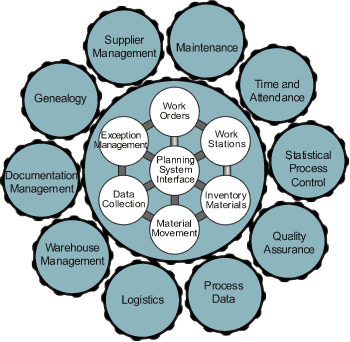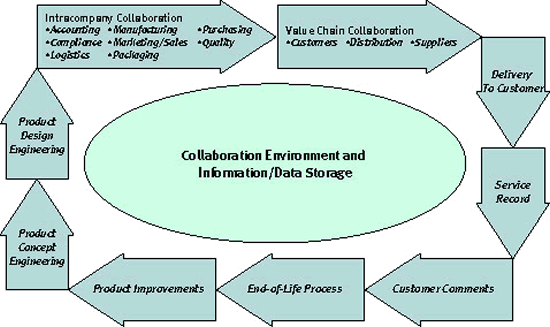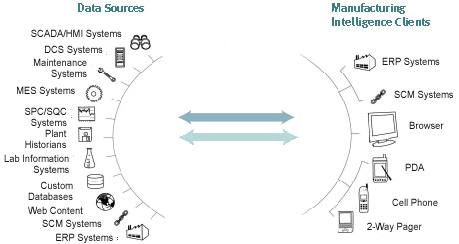The Collaborative Effect
New business strategies and processes are putting pressure on IT to produce real-time information. Some of the most valuable stuff is held in manufacturing execution and plant processing systems. Integrating these resources is hard -- but competitive business value is the reward.

Investments made in production process and value chain systems are playing a larger role and gaining in value as companies move toward collaborative uses of data to support core business processes. Originally, companies acquired these systems to support narrow functional requirements such as production order tracking, quality assurance, warehouse management, or maintenance management. However, in the new environment of collaboration, information sharing, real-time business, and broader compliance requirements, their place and value in the corporate IT portfolio hierarchy is increasingly significant.
Gaining Attention
Manufacturing systems have long been largely ignored and taken for granted. Compared to the enterprise resource planning (ERP) systems, customer relationship (or requirements) management (CRM) applications, or even supply chain management (SCM) systems, companies have often treated production support needs such as manufacturing execution systems (MESs) or warehouse management applications as unwanted stepchildren. Although needed, loved, and protected by departmental managers, most plant systems have been difficult to justify on the basis of reduced costs and usually fall below the radar screens of most corporate IT managers.
Times are changing. Now, organizations are placing a much higher value on the information detail generated and used by events and processes within production and logistics worlds. This is where the value-adding action is — especially within manufacturing organizations but increasingly in many concerns where operating in near real time is critical. Reports about yesterday's events are coming too late or lack the detail necessary to support daily business decisions. In the "sense and respond" environment of many modern businesses, data generated by events as they're occurring offers the best basis for management decisions and actions.
The Manufacturing System
It's difficult to easily identify or define the full range of applications that are used to accomplish production because industries are different and vendors have never hesitated to add to the confusion by using labeling to suggest differences. The broad definition begins with a holistic view that includes the complete production system infrastructure, the collection of business processes that provide the event-by-event real-time management, and the execution of the planned production requirements. But even that isn't an adequate definition until we include each enterprise in the value chain on both the supplier and demand sides.
In an individual plant there could easily be 40 or more applications generating information or controlling manufacturing processes. Figure 1, which I used in an earlier article (see Resources), shows many of the typical plant processes. Although the term has wide meanings, for purposes of this article I'll describe the collection of these applications as the MES and/or the enterprise production system.

Figure 1: Manufacturing execution system.
Life would be easy if the plant processes were as simple as Figure 1's illustration suggests. Unfortunately, reality is a bit messier, with plants typically running 20 to 40 different applications that have been installed over the past decade or more. Within a multi-plant company or within a supply chain, the number of applications can grow to hundreds of disparate data generators and information sources. The value of these applications has been typically based on each system as a standalone answer to a particular set of operation conditions. Considering the aggregate value of the manufacturing execution system doesn't happen because business tends to think of these applications within the confines of a data-centric view.
Because the data-centric view is narrow and focuses on the original requirements to support a specific process, organizations tend to design and build functionality with a very inward sense. As an example, consider an application designed to support the quality assurance department. Although important quality management issues (including statistical process control, nonconformance measurement and statistics, corrective action support, in-process test, and more) are usually included, rarely will the package address or have any connection to equally important issues, such as work-in-progress tracking, cost variance, and scheduling, for example.
Early material requirements planning (MRP) systems were often described as closed-loop systems. The operator entered data; the software did the calculation; and clear truths emerged. It was indeed a closed loop that focused on internal mechanisms (pure logic unadulterated by outside forces) to deliver answers. This inward focus toward a narrowly identified list of departmental functions drives the frequent reference to many plant systems as "islands of information." We can envision a much greater value for these systems when we alter our thinking away from the data-centric to a process-centric view.
Shifting to Collaboration
A major shift is occurring away from the historical use of information solely for managing a plant floor department or function toward its use for a much broader role of providing real-time information necessary to manage enterprise business processes and support collaborative initiatives across the value chain. In life-science industries, for example, process applications provide FDA regulatory compliance confirmation information. In discrete item industries, the primary source for product genealogy information, including component sourcing, quality-assurance confirmation, and product run-in test data resides in process applications. Meaningful key performance indicators and business performance management initiatives are likely to require the key data items — items that are found in the production system and available in near real time.
Business management is increasingly using a business process focus as we drive toward greater participation in information sharing and collaboration. Organizations are addressing broader real-time business issues through initiatives such as analytics, business activity monitoring/management, business process intelligence, performance management, digital dashboards, supply chain event management, collaborative value chains, product life-cycle management, and the real-time enterprise. All of these initiatives center on the idea of real-time information sharing and use, preferably from its originating source. In the typical value chain, these sources are the MESs within the business unit and/or value chain partners.
The value of the information changes when organizations use it to support higher-level business processes. There's one value to data generated for a department supervisor for management purposes and quite another value when the data is also used, for example, for Sarbanes Oxley Act compliance. The value of quality assurance information increases substantially when used to support enterprisewide warranty exposure issues. Inventory information takes on a different look when viewed across a value chain with synchronized schedules based on real demand. This greater value that comes from changing from a data-centric view of manufacturing applications to a process-centric view of systems that can support higher-impact company processes.
Processes Demand Real Time
Many newer business initiatives, including applications of collaborative manufacturing strategies, require near real-time information availability to satisfy even simple needs. The strategy of synchronizing inventories and production across a value chain requires knowing the current status of events, what's occurring at this moment, what's expected, and so on. It's not enough to have a report of what happened last week or even yesterday. To be "in sync" requires current knowledge from the processes themselves — not an assumption of what was scheduled or what should've happened. Other forms of synchronized production, including lean manufacturing and demand-driven manufacturing, are based on manufacturing to actual demand in an online environment, and completing the management information loop with process data that confirms compliance with value-chain objectives. The ideas behind these management concepts are based on near real-time interaction of confirming information among value chain partners using the full array of production system components as intelligent information sources.
Product life-cycle management (see Figure 2) can include data from product design through end of life processes. Many of the components of product life-cycle management are supported by data that originates during the manufacturing process and is stored in production applications. Product genealogy information such as test results, quality assurance data, and component source information are a few examples.

Figure 2: Product life-cycle management: Representative steps in a value chain product life cycle.
Tough Data Access
The hard part of incorporating production data into wider use is the problem of retrieving the specific required data and arranging the data in a context that supports a business process. Historically, this has been very difficult. Most IT departments aren't closely connected to plant operations or the various MES components; they have little awareness of what data is available or how to retrieve it. A midsized facility could have 60 or more disparate components within its MES. Many of these applications very likely were built to specifications long since forgotten, using technology that's no longer current. Documentation is frequently poor or nonexistent. Furthermore, when IT locates and identifies the desired information, the cost and time to integrate the data sources on the plant floor have proven prohibitive.
Vendors are improving data accessibility in different ways. Many are moving to broaden their product/function footprints. Most have perceived the necessity of including a wider range of information in their systems, often with a particular emphasis on quality assurance, product life cycle, and genealogy information. Other vendors are building extensive product offerings through acquisition, with the apparent plan to integrate this functionality into modular product suites. There are a few companies that are providing fully integrated MESs that include modules for warehouse management, scheduling, product data management, process modules, maintenance and repair, quality management, and Web services.
Employing Process Layers
One other idea gaining in popularity is the inclusion of a process layer that can easily link to data sources, retrieve specific data, perform process logic, and deliver an output. Companies are applying manufacturing intelligence systems such as that supplied by Lighthammer Software to bring appropriate information into context for presentation and analysis (see Figure 3). Lighthammer and similar systems have the ability to extract real-time process information from plant-focused sources, aggregate the data from dissimilar sources into a meaningful context, and provide actionable intelligence.
Companies are also greatly expanding the use of business process management (BPM) tools to retrieve information from disparate sources, redefine data context and logic, and provide aggregated data in other systems. One BPM vendor includes a linkage capability that has been designed specifically as a BPM tool to implement process logic between new and legacy MES components. One example of this is to link quality assurance data with a supply chain event management system to monitor yield information, and then broadcast results to internal users. An additional step might be to provide that data to the planning and scheduling system in real time for automatic rescheduling. To extend this concept further, a company could inform downstream value chain partners of the quality assurance data, the resulting yield, the revised schedule, and current shipment information as developed in the logistics management system.

Figure 3: Manufacturing intelligence systems have the ability to extract real-time process information from plant-focused sources, aggregate the data into a meaningful context, and provide actionable intelligence. (Courtesy of Lighthammer Software)
Value Elevation
Manufacturing companies' moves to collaborate more closely and approach a real-time information paradigm is revising the value proposition of MES. In previous times, applications were typically narrow in scope, thus making return on investment justification difficult. In tomorrow's manufacturing enterprise, MES intelligence will more directly support enterprise and value chain objectives aimed at inventory management, improved customer service, shorter process cycle times, true competitive advantages, improved profitability, and wider stakeholder success. Support for these higher-level business processes is providing a new role for MESs as major sources of enterprise intelligence, driving their current renaissance.
Michael McClellan is president of Collaboration Synergies, an advisory company focused on collaborative manufacturing systems development and implementation, plant floor information systems, and MES. He has more than 30 years of experience serving and managing manufacturing enterprises, and was a founder of Integrated Production Systems. He's the author of several books, most recently Collaborative Manufacturing: Using Real-Time Information to Support the Supply Chain (CRC Press, 2002).
Resources
"Execution Systems: The Heart of Intelligent Manufacturing," June 12, 2004
www.intelligententerprise.com/showArticle.jhtml?articleID=21400431
About the Author
You May Also Like






